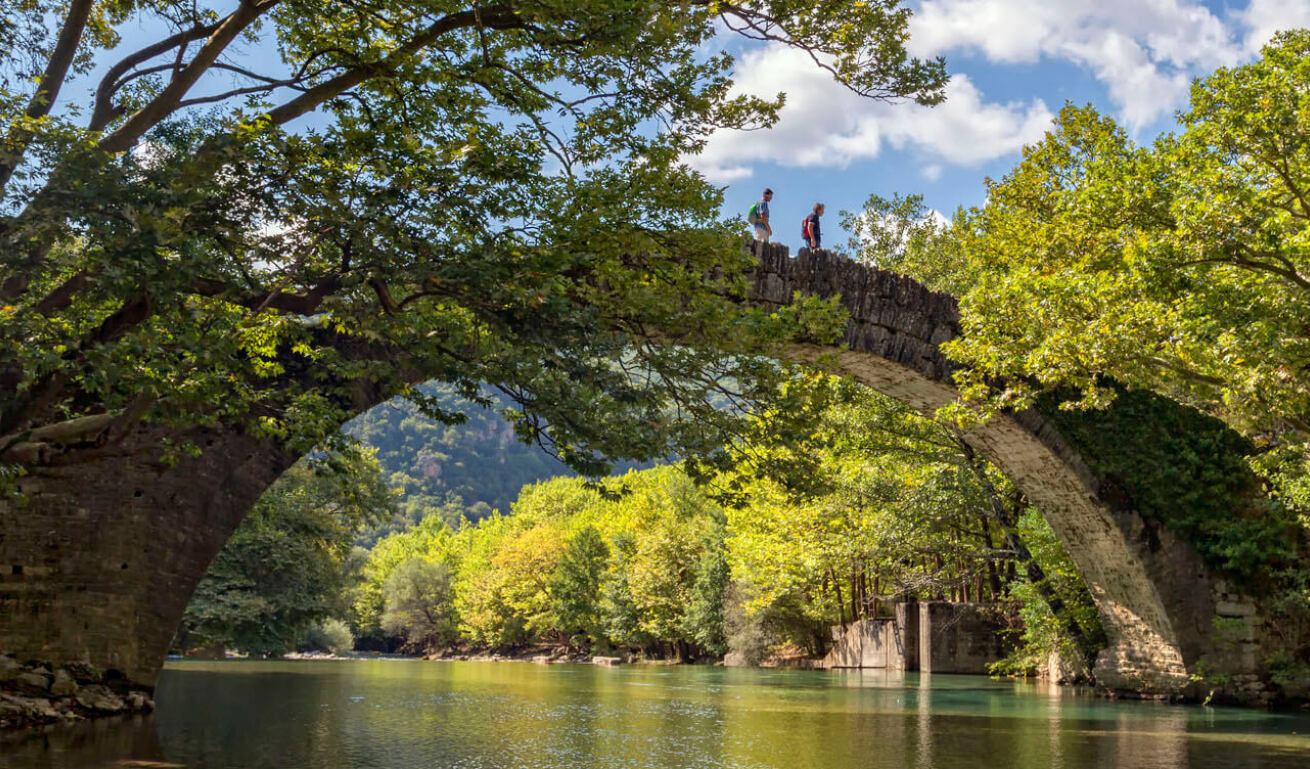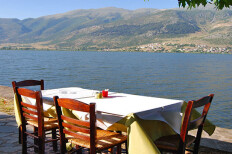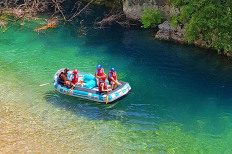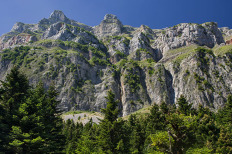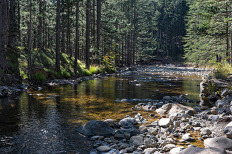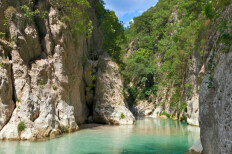

Epirus
The Pristine Paradise of Mainland Greece
Epirus lies in NW Greece, between the Pindos mountain range and the Ionian Sea. Its untouched mountainous mass of Pindos with its great virgin forests, the Dragon Lakes (the mythical mountain lakes) and the untamed slopes provide a plethora of activities (mountaineering, climbing, ski, hiking, mountain biking etc.) in a scenery of singular beauty, as well as the rivers of Epirus which offer other activities such as kayak, rafting, canoeing etc. Arachtos especially, is considered as one of the most beautiful and challenging rivers for kayaking, while Voidomatis runs through the impressive gorge of Vikos.
All of this co-exists in harmony with the archaeological sites, castles, monasteries, churches and traditional villages. Among them is Zagorochoria (Zagori), a group of 46 villages spread across the mountain slopes, which in 2023 was inscribed on the UNESCO World Heritage List as a cultural landscape – the first in Greece to receive this distinction. In close proximity, you can find Vikos Canyon, the second deepest in the world, with an ecosystem of 1.700 plants and 182 animals. Cross the historic stone bridges of Epirus, where legends and local traditions leave their mark on these architectural masterpieces of superb craftsmanship. Explore Dodoni, the place where the famous oracle used to be in ancient times, pay a visit at the famous Theater of Dodoni, the largest in antiquity and finally taste some of the most delicious feta, the cheese par excellence of Greece.




Popular Destinations

Ioannina
A journey in a magical land
Ioannina, the capital of Epirus, spreads out around beautiful Lake Pamvotida. The natural environment, the climate and character of the town are defined by this stretch of water – the area’s trademark. The lake, with its still waters and its small island, is a natural monument, around which the entire area lives and breathes. The strong cultural traditions of the town, home to a number of great novelists and poets, and the artistic and intellectual events which are organized throughout the year, give visitors the opportunity to get to know the roots of the intellectual life of Epirus.
A walk through the city has the feel of a bygone era, full of secret places and legends still living. Wonderful buildings like the House Matei Hussein, the Ottoman mosque of Veli Pasha and the entire historic centre of the town are unique attractions.
Ioannina was always multicultural, dominated mainly by Christian, Islamic and Jewish influences. This coexistence of cultural influences is clearly evident in the historic city centre. The Stoa Louli arcade is one of the locations where the three communities worked together and prospered. The arcade was originally an inn and then became a mercantile exchange of great importance throughout the whole of Epirus.

Zagori
At the heart of Epirus, nestled among the steep and snowy slopes of Tymfi mountain range, you will find Zagorochoria National Park, one of the most beautiful and rich ecosystems in Europe.
In 2023, the breathtaking Zagori Landscape was inscribed on the UNESCO World Heritage List as a cultural landscape, gaining international acclaim for its unique combination of natural splendor and the timeless imprint of human civilisation.
A cluster of 46 picturesque traditional villages in the wider area of Timfi, Pindos and Mitiskeli (Zagori region), built in a magical setting amidst pine and fir trees is waiting to be discovered all year round! Zagori's natural environment is exquisite and perfect for many outdoor activities. The unique local architecture is defined by stone, wood and slate rock.
The impressive stone mansions and the undulating, natural forested surroundings are the ingredients of an unparalleled destination that should not be missed! Zagori is divided into three areas, the Western, Central and Eastern Zagori. Let's discover the villages of Zagori, one by one!
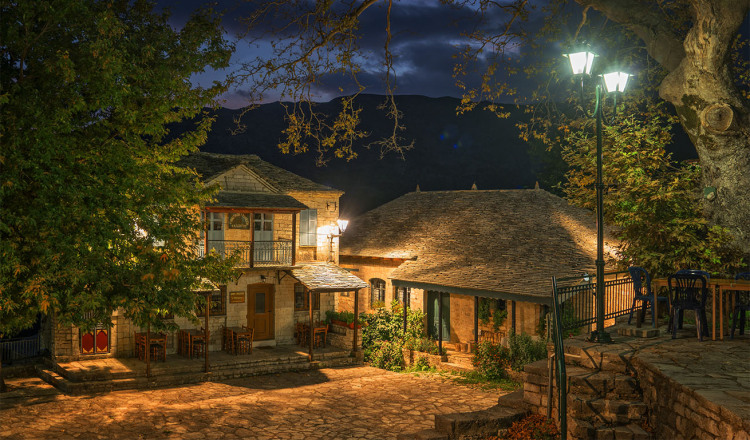
Tzoumerka
In the eagle's eyries of Epirus
In the mountainous heart of Greece, among the rugged peaks of Mount Pindos, you will find 47 scattered villages throughout the Athamanian Mountains, known as the Tzoumerka Villages.
The Tzoumerka form the natural border between Epirus and Thessaly and are also known as the Athamanian Mountains.
You will be enchanted at first sight by the wild natural beauty of the mountains, the abundant waters, the charm of the stone-built villages, but most of all, by the open-hearted people and the rich local tradition. In this mountainous region, between Arachthos river to the west and Acheloos to the east, you will encounter landscapes of authentic natural beauty and significant human landmarks, such as stone bridges and monasteries hidden among the rocks. Artificial lakes, caves, imposing canyons, and rugged peaks will be imprinted in your travelling memory forever.
Throughout the area, opportunities for alternative activities are generously offered, with rafting on the Kalarritiko and Arachthos rivers being a top choice. From Vourgareli, Athamanio, and Theodoriana, the "fir-loving" villages of Tzoumerka, Kypseli, Katarraktis, Plaka with its famous bridge, the amphitheatrically built Agnanta, Raftanaioi, Ktistades, busy Pramanta with its renowned grills, all the way to the twin aristocratic villages of Syrrako and Kalarrites, the place is filled with breath-taking scenes! Tzoumerka are mainly for nature lovers and those seeking journeys on unbeaten paths and adventure in nature. The accommodation options include guesthouses in mansions, hotels, and wooden chalets.

Metsovo
The jewel of Epirus
Metsovo, a lively mountain town in Epirus, with its diverse history, traditions and customs is a popular winter holiday destination. This tree-shaded village, retaining its traditional character, dots the mountain side below Katara Col (Katara pass) in the Mountain Range of Pindos. It is full of life throughout the year generously offering you its natural surrounding beauties. The soothing sound of water always on the move adds to the majestic atmosphere. Half hidden in the fog or wrapped in a snow blanket as winter sets in; Metsovo practically looks like a painting.
Particularly during winter, the famous vlach village, birthplace of various national benefactors (Tositsas, Stournaras, Averof etc.), is Epirus’ beloved holiday destination.

Parga
The Riviera of the Epirus Region
Parga is a renown maritime town of Epirus as well as a famous holiday destination. It is amphitheatrically built nestled in a picturesque bay, where the wooded small island of Panagia lays under the shadow of the towns’ Venetian castle. Take a stroll up to the old town where you’ll enjoy some distinguished architecture, wander around its cobbled stone streets with beautiful arches, discover flower-filled neighborhoods where picturesque little houses and colorful mansions and end up by drinking in the mesmerising sunset view of the emerald waters of the Ionian Sea from the Venetian walls.
By nightfall take a romantic walk by the waterfront lined by tourist shops, beautiful stylish restaurants and little bars to drink or eat with a view to the lit up castle and Panagia islet.

Preveza
Preveza town is located at the mouth of Amvrakikos Gulf, in Western Greece. It is an area blessed with beautiful landscapes, green areas, great beaches, a rich history, ancient sites and monuments; in short you will find here numerous options for memorable holidays. Stroll along the harbour and the old town and see the beautiful traditional buildings; walk on the seaside pedestrian street and enjoy the island-like atmosphere; taste local dishes in a picturesque taverna or coffee shop which line the narrow slab-paved backstreets.
It is the capital of Preveza Regional Unit where you will find the local administrative, commercial, cultural and tourist services.
Present day Preveza was built on the site of ancient Vereniki town, which was founded by Pyrrhus, the Greek King of Epirus in 290 BC. Preveza was built during the late 11th c., after ancient Nikopolis town was deserted. It was conquered many times across the centuries, until it became part of Greece in 1912.

Syvota
The Ionian fjord!
Βlue and green, representative of Thesprotia’ s Prefecture, is the main reason why Syvota is considered as one of the most exotic destinations within Greece; lacy shores, luscious green islets, long sheltered beaches with crystal clear waters and secret coves, are just some of the settlement’s characteristics that nature has open handedly offered. It is the perfect stop for sailors of the Ionian archipelago, nevertheless it is a must destination for all.
At a short distance from the coast you’ll find the small islands of Mavro Oros (meaning Black Mountain) Agios Nikolaos, Mourtemeno as well as other smaller islets. Take note that it is worth it to rent a boat and sail the calm waters of the area. Discover your own secret coves or shores (our favourite ones are the beaches Diapori and Alati (meaning salt)) and let the magic of paradise overtake you.

Arta
Built on the edge of the Peranthi hill and the banks of the Arahthos river (which provided irrigation for ancient Amvrakia), Arta is undeniably known for its famous bridge. According to the myth, the foreman's wife lays in its foundation. In 168 B.C., after the city was pillaged by the Romans, its residents fled to Nikopolis. It has been capital many times, while as ancient Amvrakia it was capital of the kingdom belonging to Pyrrhus, the king of the Molossians. In 1204, it became the capital of the Principality or Despotate of Epirus, where it flourished.
Today, Arta is the Capital, transport hub, as well as the prefecture's commercial and administrative centre. The city is studded with archaeological sites and is full of life, with charming pedestrian zones, modern shopping centres, cafès and bars.
The prefecture of Arta contains imposing mountains covered in spruces, fertile plains, roaring rivers and lagoons with important ecosystems. It is one of Greece's most beautiful regions and is located between the Tzoumerka mountain range and the Amvrakikos gulf. It makes up the north-eastern part of Epirus. The varied scenery of the prefecture combines the beauty and harshness of the Greek mountains with the gentle and shallow beaches of the gulf of Amvrakikos and the fertile valleys of the Arahthos river.
Nature at its best
Aoos, especially, is considered as one of the most beautiful and challenging rivers for kayaking, while Voidomatis runs through the impressive gorge of Vikos. All of this co-exists in harmony with the archaeological sites, castles, monasteries, churches and traditional villages.

Local Dishes
VIEW ALL
Tips for your Trips
VIEW ALL
Mountain biking in Epirus
Epirus is the region of Greece with steep and imposing relief, criss-crossed by mountains and rivers ideal for mountain bike enthusiasts.

Kokkinopilos, the Singular Red Clay Hills of Preveza
The mysterious landscape of Kokkinopilos (red clay) hills in Preveza is located between the villages of Agios Georgios and Rizovouni.

Rafting in Epirus

Dragon Lakes

Lakes reflecting beauty
Like stunning mirrors of outstanding natural beauty, lakes in Greece reflect the splendour of the Greek landscape in their waters.
